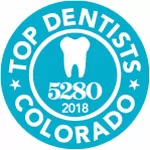A recent CDC report provides the following data related to the prevalence of periodontitis in the U.S.:
- 47.2% of individuals aged 30 years and older have some periodontal disease.
- Periodontal disease increases with age, 70.1% of people 65 years and older have periodontal disease.
- This condition is more prevalent in men than women (56.4% vs 38.4%), those living below the federal poverty level (65.4%), those with less than a high school education (66.9%), and current smokers (64.2%)
What is the cause of gum disease?
Bacteria are always present in your mouth. When you don’t brush it off with brushing and flossing, it causes inflammation. The gums around and between teeth become inflamed.
The film of bacteria first turns to plaque. The plaque is fairly soft. Dental hygienists can remove plaque when they perform a professional dental cleaning.
If the plaque is not cleaned away, it hardens to tartar or calculus.
Tartar build-up can spread below the gum line, which makes the teeth harder to clean. Then, only a dental health professional can remove the tartar and stop the periodontal disease process. CDC
You can reverse gum disease
The good news? Brushing and flossing can clear away bacteria before it turns into plaque! Therefore, in its early stages, gum disease can be reversed.
Let’s discuss how to floss:
- Cut a length of floss about 18 inches long.
- Securely wind each end around your middle fingers.
- Take hold of the floss with your forefinger and thumb leaving about two inches to work with.
- Thread the floss between two teeth.
- Hold the floss tightly against the side of the tooth and move it up and away from the gum line. You want to clean the space between the tooth and gum without pulling more gum tissue away, so it’s important to scrape up and out of the pocket.
- Move the floss around the tooth to clean every surface—especially those that your brush can’t reach. As you use a section of floss, unwind from one hand to access a clean piece. With 18 inches, you should have enough to provide a clean section for every tooth. If you run out, that’s okay. Just toss the used piece and cut a new one.
Some men and women find it more straightforward to start on one end of the upper teeth and clean each gap one by one until they reach the end on the opposite side. Then repeat for the bottom row. Whatever operation you select, make sure you clean around every tooth, including the back surfaces of the last molars.
Regular checkups and dental cleanings help prevent gum disease. At Almeida & Bell Dental Cosmetic, Implant & Sedation Dentistry in Lone Tree, we are taking new patients. Give us a call the schedule an appointment.
Contact Almeida & Bell General, Cosmetic & Sedation Dentistry:
303-858-9000
Locations (Tap to open in Google Maps):
Almeida & Bell Dental – Lone Tree
8683 E Lincoln Ave Ste 200
Lone Tree, Colorado
80124
Almeida & Bell Dental – Denver
9126 57th Ave.
Denver, Colorado
80238














